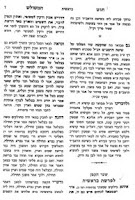While we have previously discussed several instances of plagiarism, I wanted to discuss one more which is interesting in its irony.
Originally printed in Vienna, in 1820, Hut HaMeshulash b’Sha’arim, was reprinted in 1998. This sefer is actually three-seforim-in-one arranged based on the order of the parshiyot. The three are from a grandfather, father and son. They are, respectively, Sha’ar Asher by R. Asher Lemel HaLevi, chief rabbi of Eisenstadt; Sha’ar HaMayim by his son-in-law, R. Jehiel Mihel, also the chief rabbi of Eisenstadt; and Sha’ar HaKoton by R. Asher’s grandson and R. Jehiel’s son, R. Moshe, the chief rabbi of Tzeilheim. This book was published by R. Moshe and has haskamot from the Hatam Sofer, R. Tzvi Hirsch Brody, and R. Dovid Deitch, which all offer extensive praise of these works. As I mentioned, this sefer was reprinted in a nice edition in 1998 which includes a newly set type, citations, an index, as well as a short introduction. The introduction notes that this reprint is the third printing of the sefer, with the second reprint in Munkatch, in 1931. While this is technically correct, a portion of the sefer was reprinted, but under a different name a different author.
In 1910 a similar family type sefer was published in Warsaw. As with the Hut HaMeshulash, it contains multiple commentaries from relatives. In this case, the Amudei Yonason by R. Jonathan Eybeschütz and the Amudei Shmuel by R. Nachman Shmuel Miodoser, a descendant of R. Jonathan Eybeschütz. The Amudei Yonason is claimed to be from a manuscript, however, it is R. Nachman’s commentary which we will focus on. Both of these seforim have rather nice haskamot from R. Hayyim Ozer Grodzinski, R. Eliezer Rabinowich, R. Eliyahu Meisels as well as R. Chaim Soloveitchik. It seems that R. Nachman actually had a more difficult time securing R. Chaim Soloveitchik’s haskamah due to R. Nachman’s first piece in his sefer. In that piece, R. Nachman ties the controversy of the earth or sky being created first, to that of Moshe and Betzalal about the construction of the mishkan and use it to explain a Midrash. R. Chaim said that such a interpretation is inappropriate, as according to R. Nachman’s explanation there are opinions which argue with Moshe and no one can argue with Moshe. [It would appear that R. Chaim took the ani ma’amins literally although, as we have
recently seen at the Seforim blog, such a formulation has little support and even the Rambam’s position is not unopposed.] R. Nacham attempted to assuage R. Chaim Soloveitchik’s concern by pointing out the Hafla’ah has a similar explanation with the same end result – someone disagreeing with Moshe. R. Chaim Soloveitchik was unsatisfied with this justification so R. Nachman agreed to remove that explanation. But, when R. Nachman reached Warsaw, that page had already been printed thus, R. Nachman instead of removing the piece, included the above story to let R. Chaim’s position be known. [Reproduced below – you can click on any of the images for a larger version.]
R. Chaim Soloveitchik’s Haskama and R. Nachman’s Disclaimer

R. Nachman attempted to justify his position by pointing to earlier authorities who said similar ideas; however, R. Nachman could have pointed to an earlier authority which said the exact same thing. The vast majority of R. Nachman’s commentary is taken almost word for word from the Sha’ar HaKoton, including the controversial explanation. It appears this plagiarism went undetected as the book was reprinted three years later in 1913 (and even more approbations appear which due to their late arrival were not included in the first edition) and then again in Bnei Brak in 1946. R. Nachman died in 1948 in Bnei Brak.
From the Amudei Yonason


the Original – Sha’ar HaKoton




